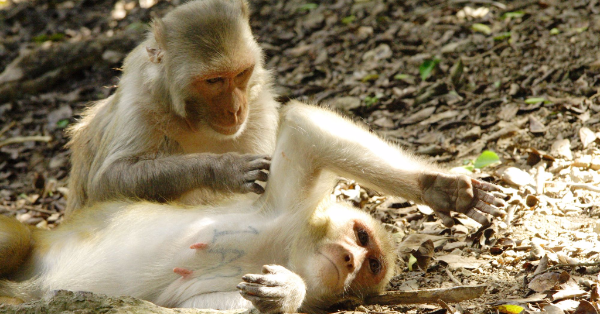
At first thought, the upstairs café and bar at Penn’s World Café Live might seem an unlikely site for a presentation by a professor whose specialties are marketing, psychology, and neuroscience. After all, the building also houses WXPN, the University’s FM radio station. Musical groups both famous and up-and-coming come through it. But on this evening, the place was filled, and there seemed to be an undercurrent of anticipation. They had all come to hear Michael Platt, PhD, the James S. Riepe Professor of Neuroscience in the Perelman School of Medicine, a professor of psychology in the School of Arts & Sciences, and a professor of marketing in the Wharton School. Appointed the 16th Penn Integrates Knowledge Professor in July, Platt arrived at the University from Duke University, where he had been director of the Center for Cognitive Neuroscience and of the Duke Institute for Brain Sciences. For this event in the Penn Lightbulb Café Lecture Series, Platt’s topic was “Friendship and Your Brain.”
“How many people came here tonight with a friend?” Platt asked, taking the spotlight with sleeves rolled up and an open collar. “Or to make a friend?” Referring to It’s a Wonderful Life, Platt continued: “Frank Capra got it right!” Although the film was panned when it came out in 1946, the themes were important: the ability to connect with other people is essential. Platt pointed out that one of the common features of autistic people is their difficulty in reading social cues. As a consequence, it is harder to make friends. And today, we are at an interesting point in our species -- interconnected, with all the electronic devices, but, Platt said, “in a weird way.” There are times when we read a response to an e-mail and say to ourselves, “Boy, did somebody not get the tone!” One of the problems, in other words, is that e-mails and texting do not deliver the same cues, the same tones of voice, that face-to-face interactions do.
Platt’s work has focused on social neuroscience, in particular why different people make different decisions and how they build social networks -- and how such decisions and inclinations are reflected in neural activity. His research with rhesus macaques, a non-human primate species that he has studied for many years on an island off Puerto Rico, has demonstrated that the monkeys with the strongest social networks and bonds are the most successful. And that is true for humans as well. In his talk, Platt cited a video that went viral a couple of years ago, showing one monkey in India trying to rouse another who had fallen on railway tracks after being electrocuted by a power cable. But what is going on in the brain of the rescuer monkey? Or what goes on in what Platt called “the three pounds of meat sitting between your ears” when a human helps a friend?
To begin to answer that question, Platt and his postdoctoral scholar at the time, Steve Chang, PhD, developed a test. A monkey is trained to donate or withhold a reward (in this case, juice) from another. The “actor” monkey can also keep the reward. In general, Platt said, when the choice is to reward the recipient monkey or to let the juice to into the trash, the actor monkeys choose to reward the other monkey. During the test, the brain sc an of the actor monkey’s amygdala shows that the neurons signaled social preferences. (The researchers call them “value-mirroring neurons,” which reflect the monkeys’ tendency to make prosocial decisions.)
an of the actor monkey’s amygdala shows that the neurons signaled social preferences. (The researchers call them “value-mirroring neurons,” which reflect the monkeys’ tendency to make prosocial decisions.)
In a related experiment, the actor monkeys are given oxytocin through a nebulizer before performing the test. The hormone, made in the brain, has been associated with social bonding in general and can be released through social touch and eye contact. Most earlier research, however, was done in rodents. Platt’s team found that about a half hour after receiving the oxytocin, the actor monkeys rewarded the other monkeys more and paid more attention to them. The hormone “lowers your normal social wariness” he said, while helping to build empathy. In fact, oxytocin is being tested for its beneficial effects on some people with autistic spectrum disorders; some research has shown that it can help them pick up social cues and become more social in general.
Platt and his team aim continue to study how genes and environmental behavior interact. Another finding in their study of the macaque colony: the monkeys with a “double whammy” of serotonin dysfunction also have a weaker social network. Among other things, they are less likely to be extroverted or have what Platt called a grooming partner.
In closing his presentation, Platt emphasized that connecting with others is important -- and such connections can activate the feedback loop that releases oxytocin and its positive effects. As he warned, however, the same benefits may not be there when the connection happens across hyperspace. Platt also mentioned that some recent work has suggested that the connection doesn’t only have to be with a fellow human. “You can try staring into the eyes of your favorite pooch” before going out for the evening, Platt said. Then he quoted the famous exhortation in E. M. Forster’s novel Howards End: “Only connect.”
Photo caption: One rhesus macaque grooms the other. (Photo: Lauren Brent)